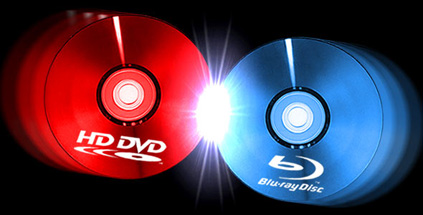|
|
Intermittent Issues:
|

|
Adding a final layer to the HD puzzle was the challenge of conveying HD video and audio to the consumer’s TV and audio system. DVDs had a maximum line resolution of 720 x 480, and the MPEG-2 video codec used for DVD content had a maximum bitrate of 10.08 Mbit/s - enough to carry compressed video and audio over the two dominant connection methods at the time: composite (the yellow, red, and white cords you remember from your childhood, or your infanthood, or [insert appropriate age-related classification here], and component (a more advanced connection method utilizing three separate cables for each of the red, green, and blue color channels prevalent in the NTSC standard). Component video had the ability to carry an HD signal, but it was far less familiar to the average consumer than composite, which was unable to carry HD. It was also more expensive to produce.New at BOP: Share & Save
![]() Tweet
Tweet
![]() Print this column
Print this column
From this complicated pool of expectations and limitations, one consortium would seek to re-conceive the optical disc format in a way that would be ideal for storage space (for reasons we’ll get to), while the other consortium would endeavor to build upon existing infrastructure while ensuring consumer familiarity wouldn’t suffer. The first party was Sony, making another venture out into new technology after their Betamax lost to VHS. The other party was the DVD Forum, an organization of multiple technology companies that had developed the DVD standard and sought to succeed it here.
|
Advertisement |
Sony and Blu-ray
For Sony, 2002 was a banner year. The final tallies wouldn’t come in until its annual report in March of 2003, but the corporation’s year-over-year increase in net income was significant. The Sony Pictures division had dominated a good chunk of 2002 with the financial successes of Spider-Man, xXx, and Men in Black II. Its PlayStation 2 gaming console had shipped its 10 millionth unit, with another 8.5 million units projected for the year’s holiday season; it was handily winning its own console war. In short, it was a bad year to be a competitor.
Blu-ray was already named and under development by the time the annual report came out in 2003; its initial announcement came in February of 2002, so its first corporate mention was actually in the previous annual report. The goals for the format in both reports were lofty: Sony had nothing less on its mind than domination of every direct or tangential market segment. Key to the development of Blu-ray was a piece of laser technology, partially responsible for the format’s name: a blue-violet laser diode, developed by Sony and operating on a wavelength of 405 nanometers (nm), capable of reading and extracting much denser blocks of data than the red-laser diode used to extract data from CDs and DVDs. The blue-violet laser diode was conceived and developed specifically for high-density optical recording and playback, and the initial anticipated results were impressive: between 23 and 27 gigabytes of storage space on a single-layer Blu-ray Disc (by comparison, a single-layer DVD stored 4.7 gigabytes, and even the dual-layer DVD only hit 8.5 gigabytes).
[ Email this column ]

|
|
|

|
Friday, April 26, 2024
© 2024 Box Office Prophets, a division of One Of Us, Inc.

